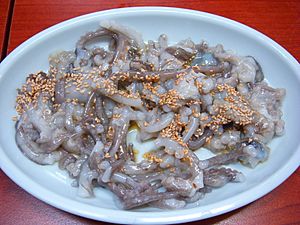San-nakji facts for kids
 |
|
| Type | Hoe |
|---|---|
| Place of origin | Korea |
| Associated national cuisine | Korean cuisine |
| Main ingredients | Long arm octopus |
| Korean name | |
| Hangul |
산낙지
|
|---|---|
| Revised Romanization | san-nakji |
| McCune–Reischauer | san-nakchi |
| IPA | [san.nak̚.t͈ɕi] |
San-nakji (산낙지) is a unique Korean dish. It is a type of hoe, which means it is a raw food. This dish is made from a small octopus called nakji in Korean. People sometimes call it "baby octopus" because it is much smaller than giant octopuses.
The octopuses are usually killed before being cut into small pieces. Even after being cut, the pieces can still move on the plate! This happens because octopuses have a very complex nervous system. Most of their nerves are in their arms. This allows them to show different reflex actions even without their brain's input. Sometimes, a live octopus is eaten whole. The dish is often sprinkled with sesame oil and toasted sesame seeds.
Eating San-nakji Safely
When you eat sannakji, you need to be careful. The suction cups on the octopus pieces can still be active. This means they might stick to your mouth or throat.
It is important to chew the pieces very well. This helps prevent them from getting stuck. If pieces get stuck, it could be a choking hazard. Always eat sannakji with care.
Different Meanings of Nakji
The word nakji can mean different things in North and South Korea. In South Korea, nakji refers to the Octopus minor. This is a small type of octopus.
However, in North Korea, nakji means a squid. So, if you hear someone from North Korea say nakji, they are talking about a squid, not a small octopus.
Where to Find San-nakji
You can find sannakji in many Korean restaurants. These are often places that serve sliced raw fish.
It is also a popular snack at bars. People often eat it with alcoholic drinks like soju.
See also
 In Spanish: Sannakji para niños
In Spanish: Sannakji para niños

